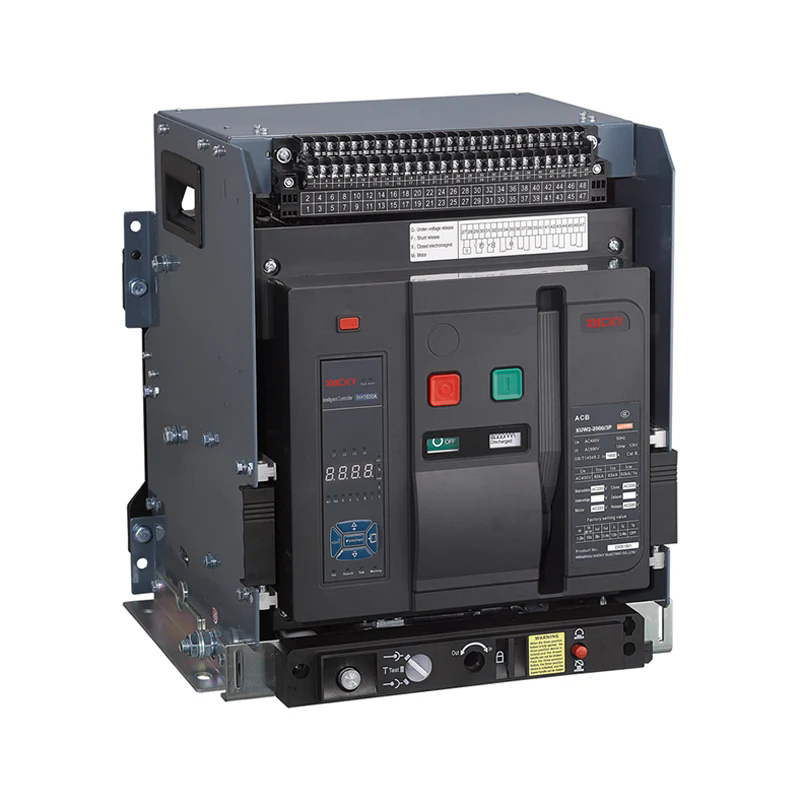Understanding Air Circuit Breakers: The Backbone of Electrical Safety
2024-12-04
Air Circuit Breakers (ACBs) are a critical component in modern electrical systems, providing safety, reliability, and efficiency in managing power distribution. Found in industries, commercial buildings, and high-capacity systems, ACBs play a vital role in protecting electrical circuits from overloads, short circuits, and other faults. In this blog, we’ll explore what ACBs are, how they work, their benefits, and why they are indispensable in electrical infrastructure.
What is an Air Circuit Breaker?
An Air Circuit Breaker is a type of circuit breaker that uses air as its arc-extinguishing medium. When a fault occurs, the ACB interrupts the flow of electricity and extinguishes the arc that forms as the circuit is broken. Designed for high-current applications, ACBs are typically used in systems with voltages ranging from low to medium levels.
How Air Circuit Breakers Work
1. Fault Detection
When an abnormality such as an overload or short circuit is detected, the ACB’s protective relays are triggered.
2. Interruption Mechanism
The breaker opens its contacts, interrupting the electrical current. This creates an arc between the contacts.
3. Arc Extinguishing
The arc is extinguished using air, which cools and disperses the energy. This prevents damage to the breaker and connected equipment.
4. System Reset
Once the fault is cleared, the ACB can be manually or automatically reset to restore normal operation.
Key Features of Air Circuit Breakers
- High Current Rating: Designed to handle large currents, often up to 6,300 Amperes.
- Adjustable Trip Settings: Allows customization of protection levels for different system requirements.
- Arc-Chute Design: Efficiently dissipates the arc energy to ensure safety.
- Manual and Automatic Operation: Offers flexibility for maintenance and automated system integration.
- Remote Monitoring and Control: Modern ACBs often include smart features for diagnostics and remote operation.
Advantages of Air Circuit Breakers
1. Enhanced Safety
ACBs protect electrical systems from severe damage by quickly isolating faults, minimizing risks of fire or equipment failure.
2. High Reliability
With robust construction and precise operation, ACBs ensure consistent performance in demanding environments.
3. Flexibility
The adjustable trip settings and modular designs make ACBs suitable for a wide range of applications.
4. Ease of Maintenance
Air-based extinguishing systems simplify maintenance, reducing downtime and operational costs.
5. Environmentally Friendly
Using air as the arc-quenching medium eliminates the need for gases like SF6, which have environmental implications.
Applications of Air Circuit Breakers
- Industrial Facilities: Protect heavy machinery and electrical systems from overloads.
- Commercial Buildings: Ensure reliable power distribution in offices, malls, and skyscrapers.
- Power Plants: Safeguard critical components in generation and distribution systems.
- Data Centers: Prevent electrical faults in high-demand environments.
- Transportation Systems: Used in railways, airports, and marine vessels to secure electrical networks.
Maintenance Tips for Air Circuit Breakers
1. Regular Inspection
Check for physical damage, wear on contacts, and proper alignment of components.
2. Testing and Calibration
Conduct periodic functional tests to ensure the breaker trips at the correct settings.
3. Cleanliness
Keep the ACB free of dust and debris to prevent malfunctioning.
4. Lubrication
Ensure moving parts are well-lubricated to maintain smooth operation.
5. Replacement of Worn Parts
Replace arc chutes, contacts, and other components as needed to extend the lifespan of the breaker.
Conclusion
Air Circuit Breakers are more than just protective devices—they are the backbone of safe and efficient electrical systems. Their ability to handle high currents, provide adjustable protection, and operate reliably in various environments makes them a vital part of modern infrastructure.
By understanding their functions and maintaining them properly, you can ensure that your electrical systems remain safe, efficient, and prepared for the demands of the future. Whether in industrial plants, commercial buildings, or power generation facilities, ACBs are an investment in long-term electrical safety and performance.



